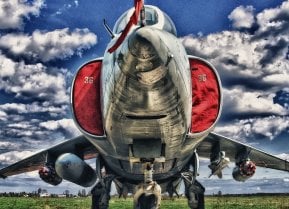Avro 730: Britain Almost Built A Mach 3 Bomber for a War with Russia
Had it entered service, the Avro 730 could have replaced the V Bombers as the primary airborne platform as a part of the UK's nuclear deterrent force.
Avro 730: The British Wanted A Mach 2.5 Bomber - In the early 1950s, the British government under Prime Minister Winston Churchill saw a significant danger in the bomber gap developing between the Royal Air Force (RAF) and the Soviet Union.
That concern led to the development of the "V Bombers" that comprised the United Kingdom's strategic nuclear strike force, known officially as the V Force or Bomber Command Maine Force. Three models of strategic bombers were developed and purpose-built to be armed with the first generation of Britain's nuclear weapons.
Known collectively as the V Class, these aircraft included the Vickers Valiant, the Avro Vulcan and the Handley Page Victor.
Avro 730 - A History
Even as the V Bombers entered service, the RAF found that it was lacking in a supersonic strategic reconnaissance aircraft, which could support the bombers during an offensive mission.
To avoid hostile air defenses, the aircraft would need to be capable of maintaining Mach 2.5 at an altitude of 60,000 feet (18,300 meters) and have the ability to attain at least Mach 3, and be able to operate at a maximum range of 5,754 miles (9,260 km).
In 1955, Britain's Avro began to develop plans for an entirely new and cutting-edge high-altitude Mach 2.5 reconnaissance aircraft. Several configurations were examined, yet all were unlike other speedy spy planes of the era. Each was a straight-wing design that featured a thoroughly enclosed cockpit with no windscreen to reduce drag. In addition, the dart-like designs employed large canards, two engine nacelles, and multiple power plants.
The embedded cockpit was in a word: unique. To streamline the aircraft, the pilot would not have been granted conventional vision and instead would have been required to operate the plane via a retractable periscope-type arrangement that would have likely presented all sorts of issues – and most certainly would have required specialized training, including for safe take-offs and landings.
Several engine configurations were considered, but the finalized form of the Model 730, which was submitted to the British Air Ministry, incorporated four Armstrong Siddeley P.159 afterburning turbojet engines that could have provided upwards of 20,750 pounds of thrust coupled with a pair of Armstrong Siddeley rocket motors that would have offered additional thrust during take-off.
The final design was developed in December 1956, and it called for a crew of two, a pilot and a navigator, who would sit by-by-side (but still have no direct view to the front).
As the aircraft was still under development, Avro decided to modify the design of Avro 730 to accommodate its arming with nuclear weapons – which would have been either a specially designed short-course weapon or perhaps Britain's Red Beard tactical bomb.
Had it entered service, the Avro 730 could have replaced the V Bombers as the primary airborne platform as a part of the UK's nuclear deterrent force.
The overly ambitious bomber concept never got off the ground, however, and the Avro 730 project was canceled – along with manned aircraft including the BAC TSR-2 – following the release of the 1957 Defense White Paper. However, some aspects of the Avro 730 lived on.
The Royal Aircraft Establishment, Farnborough, was able to utilize some of the design aspects, which were subsequently employed with the Concorde SST program in the 1960s.
About the Author
Peter Suciu is a Michigan-based writer who has contributed to more than four dozen magazines, newspapers and websites. He regularly writes about military hardware, and is the author of several books on military headgear including A Gallery of Military Headdress, which is available on Amazon.com. Peter is also a Contributing Writer for Forbes.
The image is of an SR-71 Blackbird. Image Credit: Shutterstock.


